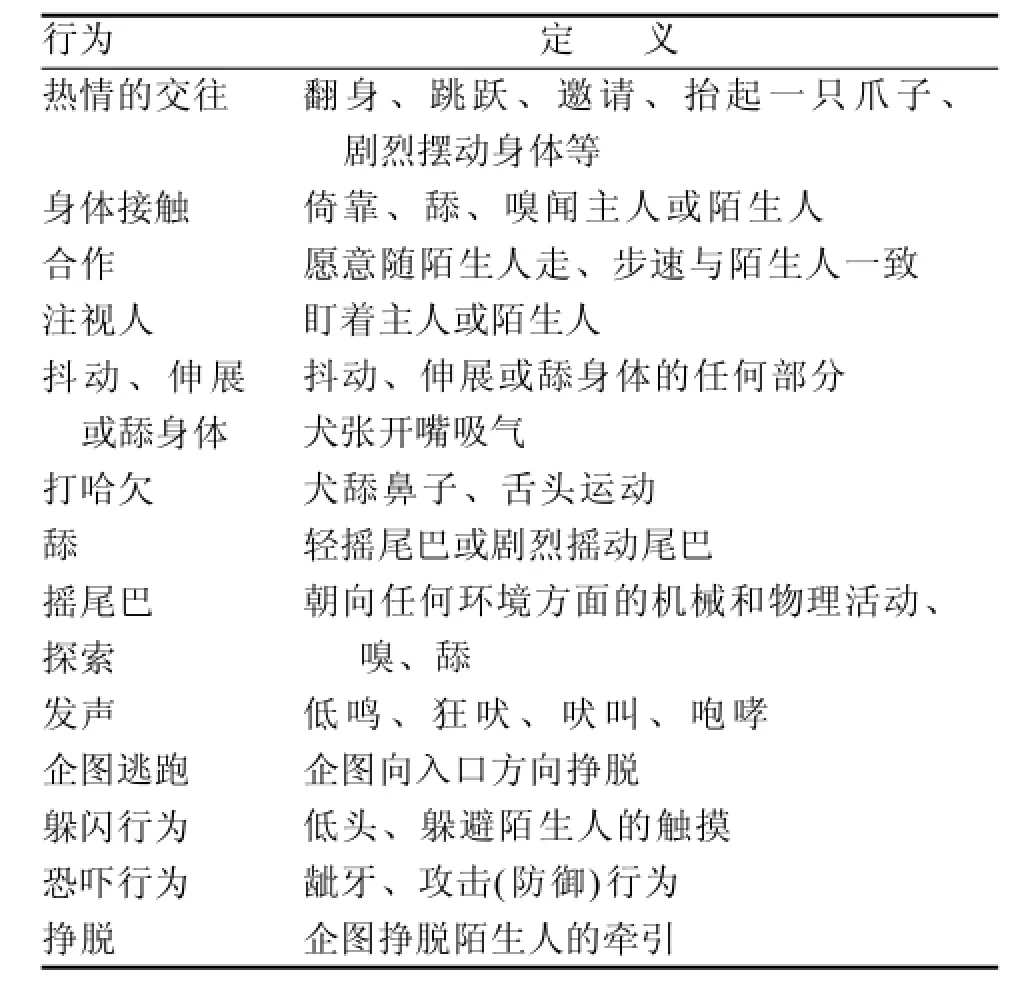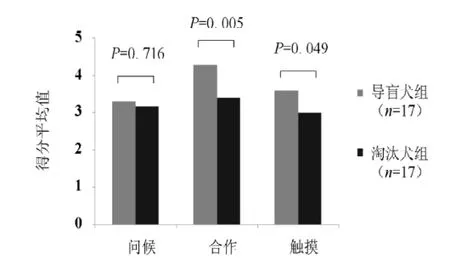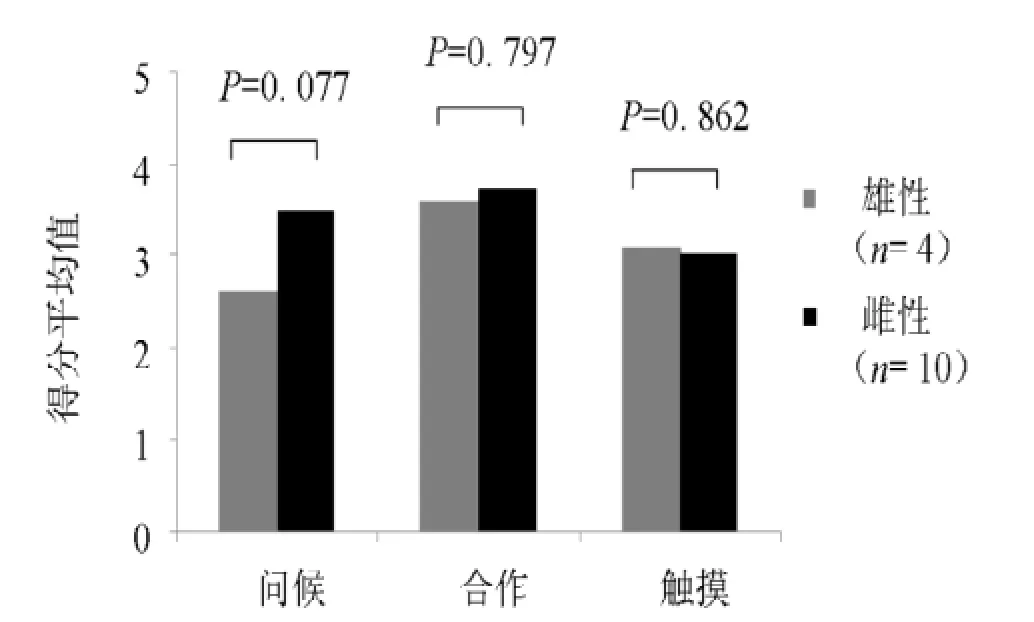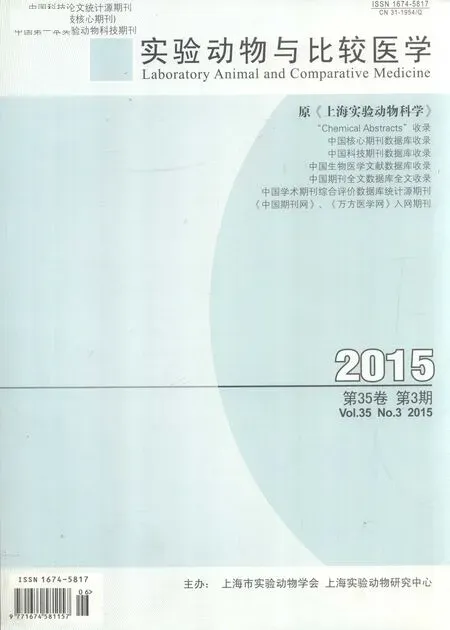社会接触测试对导盲犬培训成功率的预测效果评价
周子娟,张雅丽,韩 芳,俞剑熊,王 亮,姜 新,王爱国,王福金,王靖宇
(1. 大连医科大学实验动物中心,大连 116044;2. 通化师院分院,通化134000)
社会接触测试对导盲犬培训成功率的预测效果评价
周子娟1,张雅丽1,韩芳1,俞剑熊1,王亮1,姜新2,王爱国1,王福金1,王靖宇1
(1. 大连医科大学实验动物中心,大连 116044;2. 通化师院分院,通化134000)
目的建立社会接触测试,并探究其预测导盲犬培训成功率的有效性。方法通过对犬心理评估(DMA)测试方法进行改良,建立了犬社会接触测试方法及相应的详细评分标准。对中国导盲犬大连培训基地提供的17只培训成功的导盲犬和17只未培训成功的淘汰犬进行社会接触测试,考查和评估社会接触测试中问候、合作及触摸这3个行为变量对导盲犬培训成功率预测的有效性。结果问候变量,导盲犬与淘汰犬的得分没有显著差异(导盲犬:=3.29,淘汰犬:=3.18,P=0.716);而合作和触摸变量,导盲犬的得分显著高于淘汰犬(合作: 导盲犬:=4.29,淘汰犬:=3. 41,P=0.005;触摸: 导盲犬:=3.59,淘汰犬:=3.00,P=0.049)。社会接触测试中,犬的品种和性别对各行为变量的得分没有显著影响(P>0.05)。结论成功建立了社会接触测试的方法及评分标准,其中合作和触摸可作为有效预测导盲犬成功率的行为变量。
导盲犬;淘汰犬;社会接触性测试;培训成功率
在导盲犬的培训过程中,为解决导盲犬培训过程中的高成本、低成功率的问题,科研人员已进行了多方面的研究[1-12]。目前应用于导盲犬预测的测试中主要分为行为学测试和生理学测试[4]。气质测试(temperament test),可判别犬的行为特征是否适合某种工作犬,是预测导盲犬培训成功率的行为测试方法之一[2]。社会接触测试(social contact test)作为气质测试的子测试,是利用特定陌生环境和陌生人的刺激,引起犬的行为反应,并通过犬的行为表现[11],判断其社会性[13],研究表明社会性良好的犬更适合作导盲犬[14]。犬的社会性方法种类繁多[11,14-18],而国内尚无导盲犬社会性测试的报道。本实验建立了导盲犬的社会接触测试及评分标准,并探讨了其对导盲犬培训成功率的预测效果。
1 材料与方法
1.1测试对象
34只测试犬由中国导盲犬大连培训基地(以下简称基地)提供,其中有拉布拉多犬(n=24,雌15,雄9)、金毛猎犬(n=10,雌1,雄9)(表1)。犬测试时为8~15月龄。犬在培训结束后(24~32月龄),依据基地的导盲犬考核标准判定为导盲犬和淘汰犬。
1.2主要仪器设备
数字硬盘录像机(海康威视DS-8100HF-ST,杭州);高清摄像头(海康威视YCW801-A23,深圳)。
1.3测试场地及设置
测试在12.40 m×4.35 m的长方形室内场地进行(图1),A、B点为陌生人(女性实验人员)在测试场地的停顿位置,C点为犬主人进入测试场地的站立位置。实验人员在工作间通过摄像机观察场地内情况。2部高清摄像头位于测试场两侧,能够记录整个实验过程及犬的行为,以便评分人员观看录像,并对犬的行为进行评分。每只犬的得分为不同评分人员(至少3人以上)评分的平均值。

导盲犬(去势) 淘汰犬(去势) 导盲犬(绝育) 淘汰犬(绝育)拉布拉多犬 8(4) 7(2) 4(4) 5(3) 24(13)金毛猎犬 0(0) 1(0) 5(5) 4(2) 10(7)数 量 合计犬品种 雌犬 雄犬 (去势/绝育)合计 8(4) 8(2) 9(9) 9(5) 34(20)

图 1 社会接触测试的示意图
1.4测试方法
1.4.1社会接触测试方法对瑞典工作犬协会的DMA测试中的社会接触测试方法进行改良[11],细化陌生人与犬接触时的过程。测试过程如下: 问候主人带犬进入测试室,接近陌生人(位点A),陌生人问候主人和犬(交谈并触摸犬的头部和身体两侧,位点C,时间为30 s);合作陌生人带犬进行10 m往返的散步,中途停下(位点B)、爱抚犬(抚摸犬的身体15 s);触摸然后陌生人将犬交回给主人(位点C),并对犬进行一个简短的身体触摸(触摸犬的头部和身体两侧)时间为15 s。
整个实验中,陌生人由同一位女性测试人员担当,测试数据以录像形式记录。
1.4.2社会接触测试评分标准实验人员通过反复观察视频数据中犬的行为表现(表2),对犬进行评分评估。
评分人员为基地的3名训犬员。犬的得分为1~5分,低分对应犬行为变量的低强度(表3)。评分细则依据表4将犬在测试中的不同强度的行为反应划分为5个等级,以利于后续分析中提取客观性数据。评分人员参照评分细则,在测试的相应阶段对犬的行为进行观察,并对问候、合作、触摸三个变量逐一进行评分。

表 2 测试中犬的行为表现
1.5统计方法
结果采用SPSS 13.0软件进行处理,应用t检验进行差异性分析。P<0.05为差异有统计学意义。
2 结果
2.1问候、合作、触摸变量对导盲犬培训成功率的预测效果评价
根据评分标准社会接触测试中三个变量: 问候、合作、触摸进行评分(图2)。统计结果表明: 对于问候变量,导盲犬的行为表现得分平均值高于淘汰犬,但两者得分没有显著差异(导盲犬:=3.29,淘汰犬:=3.18,P=0.716)。而合作和触摸变量的导盲犬的行为表现得分平均值高于淘汰犬,两者得分存在显著差异(合作: 导盲犬:=4.29,淘汰犬:=3.41,P=0.005;触摸: 导盲犬: =3.59,淘汰犬:=3.00,P=0.049)。

表 4 社会接触测试各变量评分依据
2.2犬的品种对各行为变量的影响
社会接触测试中犬的品种对各行为变量的得分无显著影响(P>0.05)(图3)。
2.3犬的性别对各行为变量的影响
剔除测试时已绝育或去势的犬,对14只犬的行为表现进行分析,社会接触测试性别对各行为变量中的得分比较中,各行为变量的得分没有显著影响(P>0.05)(图4)。
3 讨论

图 2 导盲犬组和淘汰犬组的各行为变量得分平均值的比较

图 4 品种间各行为变量的得分平均值的比较

图 4 性别间各行为变量的得分平均值的比较
社会接触性作为导盲犬培训必备的气质因素之一[18],可用于预测导盲犬培训成功率。社会接触性贯穿于犬的一生,是工作犬训练和使用的基础[19]。犬的社会接触性可通过犬在各种环境刺激下的行为表现进行测试[20]。通过犬在测试中的表现,可以预测犬的恐惧性、依恋性和合作性,而这些因素及社会性均可以用来预测犬能否适合导盲犬的工作[14,21-23],社会接触性较好的犬能够克服恐惧、分离焦虑等外界干扰因素,积极的投入到与人的互动中。Lara的实验证明,社会接触性良好的犬,更适合培训成为导盲犬[14]。本研究结果也表明,社会接触测试可作为预测导盲犬培训成功率的有效方法。
社会接触性测试中的合作变量可有效预测导盲犬培训成功率。合作变量主要考察犬是否能够克服恐惧和分离焦虑,犬在社会接触活动中表现的意愿性、以及犬对人的服从性[18]。Angelo 等在研究中发现,合作性是训练工作犬的基础,提高犬与陌生人的合作能力有助于导盲犬完成共同训练[24]。本研究结果表明,导盲犬的合作变量得分显著高于淘汰犬,合作变量是有效预测导盲犬培训成功率的指标。
社会接触性测试中的触摸变量可有效预测导盲犬培训成功率。触摸变量主要考察陌生人触摸犬的身体时,犬的反应。导盲犬与其他犬相比,需接受较多的身体接触,降低犬的身体敏感度,可增进犬与人之间的感情[25]。Palestrini,Paola,Wilsson等[26-28]研究表明,犬与人之间的身体接触是传递一种依恋关系的信号,依恋性是培养犬服从性的基础,稳定的依从关系有助于提高导盲犬的社会认知能力。本结果表明,导盲犬的触摸变量得分显著高于淘汰犬。可见,触摸变量是有效预测导盲犬培训成功率的指标之一。
社会接触性测试中的问候变量不能对导盲犬培训成功率进行有效预测。问候变量主要是考察犬能否克服对陌生环境和陌生人的恐惧,接受陌生人的问候。对不同品种的犬的研究表明,在陌生环境下,与陌生人接触时会引起犬潜在的恐惧,而恐惧是导致导盲犬培训失败的主要原因之一[17];Goddard等[21]在拉布拉多犬、金毛猎犬以及其他品种犬的研究中证实,接触多样社会环境的刺激,会避免犬因恐惧而影响正常工作。本研究中,导盲犬和淘汰犬在问候变量的得分没有显著差异。本文作者认为,这可能是由于测试犬种的行为特征造成的。由于拉布拉多犬和金毛猎犬具有亲和性好、互动性强、无攻击性的天性[29],是导盲犬的首选犬种。因问候变量中这两种犬的得分相近,使其不能成为预测导盲犬的成功率的有效变量。
综上所述,本研究建立的社会接触测试方法及评分标准,为提高导盲犬的培训成功率的气质测试提供了一种有效测试方法。社会接触测试中的合作和触摸变量可作为有效预测导盲犬成功率的行为变量。
[1]王爱国,王福金,王 亮,等. 气质测试在导盲犬培训中的应用[J]. 畜牧与兽医,2012,44(2):45-47.
[2]王福金,王爱国,王 亮,等. 偏侧性测试在预测成功导盲犬中的应用[J]. 实验动物科学,2012,29(3):57-60,63.
[3]李慧玲,王亮,董建一,等. 动物行为学应用—导盲犬的培训与应用情况简介[J]. 实验动物科学,2010,27(4):81-82.
[4]詹红微,王爱国,姜新,等. 导盲犬运动偏侧性测试方法的比较[J]. 实验动物与比较医学,2014,34(6):490-495.
[5]俞剑熊,张雅丽,周子娟,等. 拉布拉多犬与金毛猎犬毛色基因MC1R(R306ter)与TYRP1(Q331ter)SNP位点的检测[J]. 实验动物科学,2014,31(2):37-41.
[6]Goddard ME,Beilharz RG. Genetic and environmental factors affecting the suitability of dogs as guide dogs for the blind [J]. Theor Appl Genet,1982,62(2):97-102.
[7]Goddard ME,Beilharz RG. A factor-analysis of fearfulness in potential guide dogs [J]. Appl Anim Behav Sci,1984,12 (3):253-265.
[8]Goddard ME,Beilharz RG. Early prediction of adult behavior in potential guide dogs [J]. Appl Anim Behav Sci,1986,15 (3):247-260.
[9] Knol BW,Roozendaal C,Vandenbogaard L,et al. The suitability of dogs as guide dogs for the blind: Criteria and testing procedures [J]. Vet Q,1988,10(3):198-204.
[10] Murphy JA. Assessment of the temperament of potential guide dogs [J]. Anthrozoos,1995,8(4):224-228.
[11] Svartberg K,Forkman B. Personality traits in the domestic dog [J]. Appl Anim Behav Sci,2002,79(2):133-155.
[12] Svartberg K. Shyness-boldness predicts performance in working dogs [J]. Appl Anim Behav Sci,2002,79(2):157-174.
[13] Svartberg K. A comparison of behaviour in test and in everyday life: evidence of three consistent boldness-related personality traits in dogs [J]. Appl Anim Behav Sci,2005,91(1-2):103-128.
[14] Lara SB,BagSc(Hons),Marjolyn B,et al. The effects of structured sessions for juvenile training and socialization on guide dog success and puppy-raiser participation [J]. J Vet Behav,2008,3(5):199-206.
[15] Goodloe LP,Borchelt PL. Companion dog temperament traits [J]. Appl Anim Welf Sci,1998,1(4):303-338.
[16] SerPell JA,Hsu Y. Development and validation of a novel method for evaluating behavior and temperament in guide dogs [J]. Appl Anim Behav Sci,2001,72(4):347-364.
[17] Hennessy MB,Voith VL. Behavior and cortisol levels of dogs in a public animal shelter,and an exploration of the ability of these measures to predict problem behavior after adoption [J]. Appl Anim Behav Sci,2001,73(3):217-233.
[18] Lara SB,Marjolyn SB,John AB, et al. Factors associated with success in guide dog training [J]. J Vet Behav,2008,3(4): 143-151.
[19] APPleby DL,Bradshaw JWS,Casey RA,et al. Relationship between aggressive and avoidance behavior by dogs and their experience in the first six months of life [J]. Vet Rec,2002,150 (14):434-438.
[20] Kis A,Bence M,Lakatos G,et al. Oxytocin receptor gene polymorphisms are associated with human directed bocial behavior in dogs (Canis familiaris) [J]. PLoS ONE,2014,9(1): e83993.
[21] Goddard ME,Beilharz RG. Genetics of traits which determine the suitability of dogs as guide-dogs for the blind [J]. Appl Anim Ethol,1983,9(2):299-315.
[22] Fallani G,Previde EP,Valsecchi P. Do disrupted early attachments affect the relationship between guide dogs and blind owners [J]. Appl Anim Behav Sci,2006,100(3-4): 241-257.
[23] Naderi GS,Scanyi V. Cooperation between the guide dog and the blind. Who leads whom [C] The 24th International Ethological Conference Abstracts,Hawaii. 1995:114
[24] Angelo G,Chiara M. Survey of undesirable behaviors displayed by potential guide dogs with puppy walkers [J]. JVet Behav,2008,3(3):104-113.
[25] Goddard ME,Beilharz RG. The relationship of fearfulness to,and the effects of,sex,age and experience on exploration and activity in dogs [J]. Appl Anim Behav Sci,1984,12(3):267-278.
[26] Palestrini C,Previde E. Heart rate and behavioural responses of dogs in the Ainsworth's strange situation: a pilot study [J]. Appl Anim Behav Sci,2005,94(1-2):75-88.
[27] Paola V,Emanuela PP,Pier AA,et al. Development of the attachment bond in guide dogs [J]. Appl Anim Behav Sci,2010,123(1-2):43-50.
[28] Wilsson E,Sundgren PE. Behaviour test for eight-week old puppies-heritabilities of tested behaviour traits and its correspondence to later behaviour [J]. Appl Anim Behav Sci,1998,58(1-2):151-162.
[29] Wilsson E,Sundgren PE. The use of a behaviour test for the selection of dogs for service and breeding,I: Method of testing and evaluating test results in the adult dog,demands on different kinds of service dogs,sex and breed differences[J]. Appl Anim Behav Sci,1997,53(4):279-295.
Evaluation on Effects of Social Contact Test in Predicting Training Successful Rate for Guide Dogs
ZHOU Zi-juan1,ZHANG Ya-li1,HAN Fang1,YU Jian-xiong1,WANG Liang1,JIANG Xin2,WANG Ai-guo1,WANG Fu-jin1,WANG Jing-yu1
(1. Laboratory Animal Center,Dalian Medical University,Dalian 116044,China;2. Tonghua Normal University branch institute,Tonghua 134000,China)
ObjectiveTo establish the methods and evaluation criterion for social contact test and detect their effects on predicting the training successful rate for guide dogs. MethodBy improving the method of dog mentality assessment (DMA),the methods of social contact test and the corresponding grading standards in detail were established. The 17 guide dogs and 17 eliminated dogs from Chinese Guide Dogs Training Centre of Dalian were used to examine and evaluate the predicting effects of the 3 behavioral variables in social contact test (greeting reaction,cooperation,and handling) on the training successful rate for guide dogs. ResultsThe scores of greeting reaction variable did not show any significant difference between guide dogs and eliminated dogs (guide dogs:=3.29,eliminated dogs:=3.18,P=0.716). While the scores of cooperation and handling variables of guide dogs were significantly higher than those of eliminated dogs (cooperation: guide dogs:=4.29,eliminated dog:=3.41,P=0.005;handling: guide dogs:=3.59,eliminated dogs:=3.00,P=0.049). The breed and gender of dogs in social contact test had no significant effect on the scores of the behavior variables (P>0.05). ConclusionThe method and evaluation criterion of social contact test was successfully established,and the cooperation and handling can be used as effective behavior variables to predict the training successful rate for guide dogs.
Guide dogs;Eliminated dogs;Social contact test;Training successful rate
Q95-33
A
1674-5817(2015)03-0207-05
10.3969/j.issn.1674-5817.2015.03.006
2014-12-01
国家自然科学基金 (31272392)
周子娟(1987-),女,硕士研究生,研究方向: 动物行为学。E-mail: zhouzijuan0512@163.com
王靖宇(1964-),男,博士,教授。研究方向: 动物行为学。E-mail: wangjingyus@163.com王福金(1964-),男,博士,副教授。研究方向: 实验动物学。E-mail: wangfujin2000@qq.com

